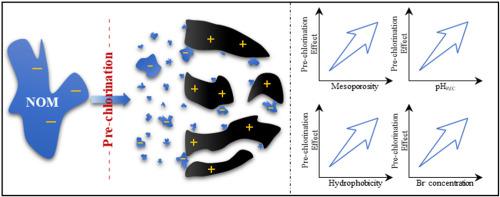Water Research ( IF 11.4 ) Pub Date : 2020-07-05 , DOI: 10.1016/j.watres.2020.116146 Cagri Utku Erdem 1 , Mohamed Ateia 2 , Chao Liu 3 , Tanju Karanfil 1

|
Pre-chlorination (i.e. dosing chlorine prior to granular activated carbon (GAC) contactors) was recently introduced as a promising method to reduce the formation of disinfection byproducts (DBPs). However, our understanding on the effect of natural organic matter (NOM) and GAC characteristics on pre-chlorination efficiency is still elusive. Thus, we have designed this systematic study to investigate the effects of GAC characteristics (i.e. surface area, pore size, and surface charge) on the subsequent reduction of DBP formation using five well-characterized adsorbents with three different NOM under three initial Br− concentrations. The results revealed that the adsorption of halogenated DBPs precursors mostly occurs in the mesoporous region (i.e. 2 nm < pore size <50 nm) of the adsorbents. Subsequently, pre-chlorination before treatment with HD3000 (i.e. GAC with the highest mesoporous surface area) decreased the formation of DBPs by 58%. Furthermore, oxidation of GAC increased the surface acidity and negatively impacted the adsorption of halogenated DBP precursors, which suggests basic GACs as promising adsorbents when applying pre-chlorination. In addition, experiments with different NOM showed that pre-chlorination was effective with higher aromatic NOM (i.e. high specific ultraviolet absorbance (SUVA254)). However, pre-chlorination of NOM with low SUVA254 has decreased the adsorption of some DBP precursors which resulted in increased formations of haloacetic acid (HAA) and total organic halide (TOX). Also, experiments with effluent organic matter (EfOM) showed that pre-chlorination did not increase the adsorption of DBP precursors in low SUVA254 wastewater effluents. Besides, increasing initial Br− concentration increased the formation of brominated DBPs (Br-DBPs) and the adsorbed Br-DBP precursors. This study gives in-depth understanding of the mechanisms, advantages, and limitations of pre-chlorination as a potential method to control DBPs formation.
中文翻译:

在GAC接触器之前添加氯气时,活性炭和有机物的特性会影响DBP前体的吸附。
最近引入了预氯化(即在颗粒状活性炭(GAC)接触器之前添加氯)作为减少消毒副产物(DBP)形成的有前途的方法。但是,我们对天然有机物(NOM)和GAC特性对预氯化效率的影响的了解仍然难以捉摸。因此,我们已经设计了本系统的研究,以在随后的还原的使用五个具有三种不同NOM充分表征吸附剂DBP形成调查下三个初始的Br GAC特性(即表面积,孔尺寸和表面电荷)的影响-浓度。结果表明,卤化DBPs前体的吸附主要发生在吸附剂的中孔区域(即2 nm <孔径<50 nm)。随后,在用HD3000(即具有最高中孔表面积的GAC)处理之前进行预氯化可将DBP的形成减少58%。此外,GAC的氧化增加了表面酸度,并对卤代DBP前体的吸附产生了负面影响,这表明碱性GAC在进行预氯化时作为有希望的吸附剂。此外,使用不同NOM进行的实验表明,预氯化对于较高的芳族NOM(即高比紫外线吸收率(SUVA 254))有效。然而,低SUVA 254的NOM预氯化降低了某些DBP前体的吸附,从而导致卤乙酸(HAA)和总有机卤化物(TOX)形成增加。同样,废水有机物(EfOM)的实验表明,预氯化处理不会增加SUVA 254低废水中DBP前体的吸附。此外,增加初始溴-浓度增加的消毒副产物溴化(BR-消毒副产物)和吸附的BR-DBP前体的形成。这项研究深入了解了预氯化作为控制DBPs形成的潜在方法的机理,优点和局限性。











































 京公网安备 11010802027423号
京公网安备 11010802027423号